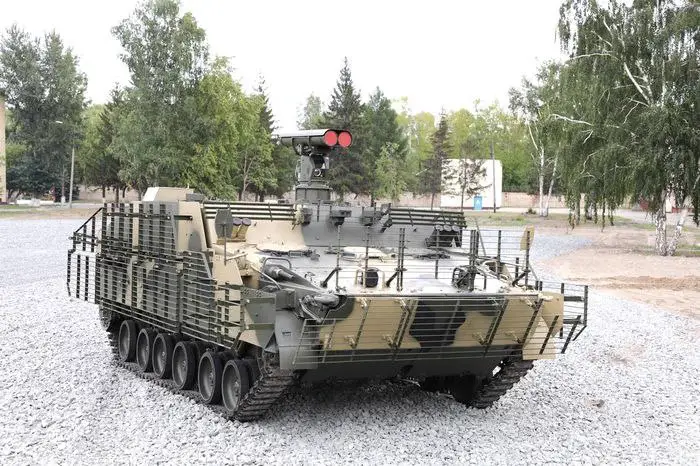Russia has unveiled a groundbreaking self-propelled anti-tank missile system tailored for marine infantry, utilizing the chassis of the BT-3F armored personnel carrier. This cutting-edge system is equipped with Kornet-E anti-tank missile launchers, and its first images were revealed by Russian media on August 11, 2023. The showcased vehicle, based on the BT-3F platform, features the distinctive Kornet-E anti-tank missile system equipped with dual launchers. Augmented with fortified armored screens incorporating welded anti-cumulative grids on the front projection and sides, this new maritime infantry vehicle demonstrates a robust design intended for anti-tank operations. One key aspect that remains under scrutiny is whether the modified chassis preserves its troop transport capabilities or if it has been entirely reconfigured for its self-propelled anti-tank role.
The BT-3F, a recently developed tracked armored personnel carrier, has its origins dating back to 2010. Leveraging the BMP-3F infantry fighting vehicle as its foundation, the BT-3F boasts enhanced amphibious capabilities. Unlike the BMP-3F, it lacks a turret but features an elevated superstructure reminiscent of the 1V172-2 artillery control vehicle. Designed to be launched from amphibious assault ships, the BT-3F’s primary function is to provide armored transport for marines from sea to shore. Once ashore, it assumes pivotal roles such as securing coastlines, conducting patrols, guarding checkpoints, and facilitating troop and supply transport inland. The BT-3F accommodates a crew of three, comprising a commander, driver, and gunner. Fourteen dismounts can also be accommodated.

Although ingress and egress are constrained due to the rear engine layout, the vehicle features two rear doors for troop access and emergency roof hatches for escape. An integral remotely-controlled weapon station, armed with a 7.62 mm machine gun, is mounted on the BT-3F. Additionally, there are two front-firing 7.62 mm machine guns, operated by two dismounts seated on either side of the driver. At the core of this formidable anti-tank system lies the 9M133 Kornet, a highly capable Russian man-portable anti-tank guided missile (ATGM) introduced in 1998. The Kornet’s prowess has been further refined in subsequent iterations, such as the 9M133 Kornet-EM, featuring an extended range and enhanced warhead.
The 9M133 Kornet (“Cornet”, NATO reporting name AT-14 Spriggan, export designation Kornet-E) is a Russian man-portable anti-tank guided missile (ATGM) intended for use against main battle tanks. It was first introduced into service with the Russian army in 1998. Beyond its portable infantry variant, the 9K133 system has been seamlessly integrated into various vehicles and weapon systems, offering a versatile anti-tank solution. The Kornet has been widely exported and is produced under license in several countries. It was first used in combat in 2003 and has since been used in many conflicts. Russia’s introduction of the self-propelled anti-tank missile system, built upon the adaptable BT-3F platform and armed with the formidable Kornet-E launchers, signifies a significant advancement in marine infantry capabilities and anti-tank warfare technology.












